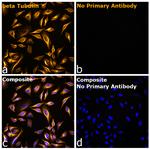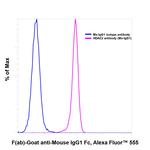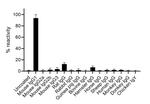Search Thermo Fisher Scientific
Invitrogen
F(ab)-Goat anti-Mouse IgG1 Fc Secondary Antibody, Alexa Fluor™ 555
This Antibody was verified by Peptide array to ensure that the antibody binds to the antigen stated.
FIGURE: 1 / 3
Mouse IgG1 Fc Secondary Antibody (A66782) in ICC/IF



Product Details
A66782
Immunocytochemistry (ICC/IF)
Flow Cytometry (Flow)
Peptide Array (Array)
Species Reactivity
Host/Isotype
Class
Type
Immunogen
Conjugate
Excitation/Emission Max
Form
Concentration
Purification
Storage buffer
Contains
Storage conditions
Shipping conditions
RRID
Target
Antibody Form
Product Specific Information
This F(ab)-Goat anti-Mouse IgG1 Fc specific antibody product is a goat polyclonal antibody F(ab) fragment that is specific to the Fc region of mouse IgG1 isotype. The product has minimal to no cross-reactivity towards mouse IgG2a, mouse IgG2b, mouse IgG3, polyclonal rat, rabbit, guinea pig, bovine, hamster, horse, sheep, human, monkey, donkey IgG, and chicken IgY as tested by direct ELISA. May show mild cross-reactivity with rat IgG2a. Cross-reactivity towards other immunoglobulins has not been tested. It is recommended that the antibody be carefully titrated for optimal performance in the assay of interest.
F(ab) antibody fragment offer several benefits over whole IgGs, due to their smaller size (~50 kD vs. ~150 kD) and the absence of the Fc region. The smaller size is expected to allow better penetration into tissue sections and improved staining in applications such as IHC. The lack of Fc region results in reduced nonspecific background staining when staining cells/ tissues with Fc receptors (such as immune cells) and other Fc interaction-related interference. Fc specific F(ab) fragments provide a range of multiplexing options beyond what is possible with whole IgGs for applications such as immunocytochemistry, immunohistochemistry, flow cytometry, and western blotting.
Using conjugate solutions: Centrifuge the protein conjugate solution briefly in a microcentrifuge before use; add only the supernatant to the experiment. This step will help eliminate any protein aggregates that may have formed during storage, thereby reducing nonspecific background staining.
Target Information
Anti-Mouse secondary antibodies are affinity-purified antibodies with well-characterized specificity for mouse immunoglobulins and are useful in the detection, sorting or purification of its specified target. Secondary antibodies offer increased versatility enabling users to use many detection systems (e.g. HRP, AP, fluorescence). They can also provide greater sensitivity through signal amplification as multiple secondary antibodies can bind to a single primary antibody. Most commonly, secondary antibodies are generated by immunizing the host animal with a pooled population of immunoglobulins from the target species and can be further purified and modified (i.e. immunoaffinity chromatography, antibody fragmentation, label conjugation, etc.) to generate highly specific reagents.
For Research Use Only. Not for use in diagnostic procedures. Not for resale without express authorization.

Performance Guarantee
If an Invitrogen™ antibody doesn't perform as described on our website or datasheet,we'll replace the product at no cost to you, or provide you with a credit for a future purchase.*
Learn more
We're here to help
Get expert recommendations for common problems or connect directly with an on staff expert for technical assistance related to applications, equipment and general product use.
Contact tech support

